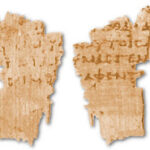Mark – Interpreter for Peter

Mark’s Gospel seems like the fairy tale stepchild of the Gospel accounts of Jesus of Nazareth. Shortest of the four and probably the least quoted, that does not mean the Gospel is less than credible or authentic.
Assessing the merit and authenticity of Mark can be approached in two ways – historical timeline and uniqueness. How far back in history can the source of Mark’s Gospel be traced? What information is exclusive to Mark, not appearing in any other Gospel?
Experts date the writing of Mark to around 60 AD possibly making it the oldest Gospel although there is debate that Matthew preceded it.[1] Evidence to the dating timeframe are two historical reference points.
Jerusalem’s destruction, which occurred in 70 AD, is not mentioned the Gospel.[2] Add to this, Mark 13:2 refers to the destruction of the Temple in future tense suggesting it had not yet happened.[3]
Origins of the Gospel’s author can be traced outside the Bible back to some of the original Disciples. Papias, an astute man born in 70 AD, made a direct reference in his writings to books “already written” which would had to have been just a few years after the crucifixion of Jesus of Nazareth.[4] His personal mission, instead, was to seek out the actual elders of the early church to ascertain the truth from them directly:
“If, then, any one who had attended on the elders came, I asked minutely after their sayings,-what Andrew or Peter said, or what was said by Philip, or by Thomas, or by James, or by John, or by Matthew, or by any other of the Lord’s disciples: which things Aristion and the presbyter John, the disciples of the Lord, say.” – Papias
Identified by name as sources by Papias are Aristion and the presbyter John, both of whom personally knew seven of the Disciples.[5] At the conclusion of his investigation, Papias provided a matter-of-fact report, saying in part:[6]
“And the presbyter said this. Mark having become the interpreter of Peter, wrote down accurately whatsoever he remembered. It was not, however, in exact order that he related the sayings or deeds of Christ. For he neither heard the Lord nor accompanied Him. But afterwards, as I said, he accompanied Peter, who accommodated his instructions to the necessities [of his hearers], but with no intention of giving a regular narrative of the Lord’s sayings. Wherefore Mark made no mistake in thus writing some things as he remembered them. For of one thing he took especial care, not to omit anything he had heard, and not to put anything fictitious into the statements.”
Irenaeus was a student of Polycarp who himself was personally mentored by the Disciple John.[7] Like Papias, Irenaeus identified Mark as the author of the Gospel, the traveling interpreter for the Disciple Peter:[8]
“…Mark, the disciple and interpreter of Peter, did also hand down to us in writing what had been preached by Peter.”
“…Mark, the interpreter and follower of Peter, does thus commence his Gospel narrative…”
Not just casual acquaintances, Mark and Luke were both part of the Apostle Paul’s ministry.[9] The Book of Acts, written by the author of Luke, mentions Mark’s name three times identifying him as “John Mark.”
In the Book of Philemon written by Paul, Mark and Luke are both called out by name.[10] Other times, Peter referred to Mark as “my son” and the Paul referred to Mark as the cousin of Barnabas.[11]
Mark’s Gospel reflects the knowledge gained during his years spent traveling with Peter and Paul; his interactions with the other Disciples; and listening to eyewitness account. If Mark referenced Matthew or vice versa, in their era it was common and acceptable writing protocol to copy information from other sources without any formal references.[12]
In the world of investigators, identical or nearly identical statements can be a clear indication of collusive deception as alleged by some Gospel critics.[13] Several differences between Mark and the other Gospels are readily apparent through simple literary analysis.
Nearly 8% of Mark, 51 verses in all, are unique content. Matthew has 28 chapters and Luke 24 whereas Mark has only 16 chapters. Writing analysis also strongly suggests Mark had the special ability to interpret both Aramaic and Greek.[14]
Unlike Matthew and Luke, Mark did not provide any genealogical details of Jesus. To begin the Gospel account, in the very first verse Jesus is declared to be the Son of God. The next two verses link an Isaiah prophecy to his introduction of John the Baptist.[15]
Miracles by Jesus solely reported in Mark are two: the healing of the deaf mute and healing the blind man at Bethsaida.[16] One parable is exclusive to Mark, the seed growing in secret, as well as possibly a second (or was it an analogy?) – the slaves in charge of a house.[17]
Activity the night before the Resurrection event is exclusively found in Mark. Named are three women, Mary Magdalene, Mary the mother of James, and Salome, who purchased and prepared aromatic spices and anointing oils to be used the following morning at the tomb of Jesus.[18]
Both Mark and Luke pick up the Resurrection story at the tomb after the stone had been rolled away. Mark reveals a very specific detail not described in the other Gospels: “Entering the tomb, they saw a young man sitting at the right.” Further, he reports the witnessing women trembled, were amazed and afraid – details not reported in the other three Gospels.[19]
Does Mark’s Gospel about Jesus of Nazareth bear the marks of credibility and authenticity?
Updated September 3, 2023.
This work is licensed under a Creative Commons Attribution-NonCommercial-NoDerivatives 4.0 International License.
REFERENCES:
[1] Ryrie. Charles C., ed. Ryrie Study Bible. New American Standard Trans. 1978. “Introduction to the Book of Matthew;” “Introduction to the Book of Mark; “Introduction to the Book of Luke.” “New Testament – Historical Books.” “New Testament.” Jewish Encyclopedia. 2011. <http://jewishencyclopedia.com/articles/11498-new-testament> “The Four Gospels.” ReligionFacts.com. 2019. <http://www.religionfacts.com/christianity/texts/gospels.htm>
Gloag, Paton J. Introduction to the Synoptic Gospels. 1895. pp 45, 204. <https://babel.hathitrust.org/cgi/pt?id=yale.39002051125079&view=1up&seq=9>
[2] “Mark, the Gospel According to.” Easton’s 1897 Bible Dictionary. 3rd Edition. n.d. <http://www.ccel.org/e/easton/ebd/ebd/T0002400.html#T0002421> Ryrie. Ryrie Study Bible. “Introduction to the Book of Mark.”
[3] “New Testament.” Jewish Encyclopedia. “The Four Gospels.” ReligionFacts.com. Gloag. Introduction to the Synoptic Gospels. pp 45, 204.
[4] Papias. “Papias.” Fragment I. “From the exposition of the oracles of the Lord.” 2005. <http://www.ccel.org/ccel/schaff/anf01.vii.ii.i.html>
[5] Schaff. Ante-Nicene Fathers. “Introductory Note to the Fragments of Papias.” <http://www.ccel.org/ccel/schaff/anf01.vii.ii.i.html> Papias. Fragment I, footnote #1739. Papias. Fragment VI, footnote #1755. <http://www.ccel.org/ccel/schaff/anf01.vii.ii.vi.html>
[6] Papias. Fragments I & VI. Swete, Henry Barclay. The Gospel According to St. Mark, The Greek Text with Notes and Indices. 1902. pp LX – LXI. <https://books.google.com/books?id=WcYUAAAAQAAJ&lpg=PA127&ots=f_TER300kY&dq=Seneca%20centurio%20supplicio%20pr%C3%A6positus&pg=PP1#v=onepage&q&f=false> Papias. “Papias.” Fragment I. “From the exposition of the oracles of the Lord.” 2005. <http://www.ccel.org/ccel/schaff/anf01.vii.ii.i.html>
[7] Schaff, Philip. “Introduction – The General Character of His Work.” Ante-Nicene Fathers. Volume I. <http://www.ccel.org/ccel/richardson/fathers.xi.i.i.html> Schaff, Philip. “Introductory Note to the Epistle of Polycarp to the Philippians.” Ante-Nicene Fathers. Volume I. n.d. Christian Classics Ethereal Library. 13 July 2005. http://m.ccel.org/ccel/schaff/anf01.iv.i.html> Gloag, The Synoptic Gospels. p11.
[8] Irenaeus. Against Heresies. Book III, Chapters I.1, X.5, XIV.1. <http://www.ccel.org/ccel/schaff/anf01.ix.iv.html> CR Acts 12:12.
[9] Swete. The Gospel According to St. Mark, The Greek Text with Notes and Indices. pp XV – XXI. Irenaeus, Against Heresies. Book III, Chapter XV.3. Papias. “Papias.” Fragment I. “From the exposition of the oracles of the Lord.”
[10] Acts 15:37; 12:12, 35; Philemon 1:24.
[11] 1 Peter 5:13; Colossians 4:10.
[12] Reed, Annette Yoshiko. Pseudepigraphy, Authorship, and ‘The Bible’ in Late Antiquity. pp 478 & 489. 2008. Academia.edu. <> Chase, Jeffrey S. “The Gutenberg Printing Press.” Duke University|Department of Computer Science. n.d. <http://www.cs.duke.edu/~chase/cps49s/press-summary.html> Fausset, Andrew R. “New Testament.” Fausset Bible Dictionary. 1878. <http://classic.studylight.org/dic/fbd> “Custom Cheating and Plagiarism essay paper writing service.” ExclusivePapers.com. 2019. <http://exclusivepapers.com/essays/Informative/cheating-and-plagiarism.php> Cummings, Michael J. “Did Shakespeare Plagiarize?” Cummings Study Guides. 2003 <http://cummingsstudyguides.net/xPlagiarism.html> Pearse, Roger, ed. “Tacitus and his manuscripts.” The Tertullian Project. 2008. <http://www.tertullian.org/rpearse/tacitus>
[13] Vick, Tristan D. “Dating the Gospels: Looking at the Historical Framework.” Advocatus Atheist. 2010. <http://advocatusatheist.blogspot.com/2010/01/dating-gospels-looking-at-historical.html> “New Testament.” Jewish Encyclopedia. 2011. Etinger, Judah. Foolish Faith. Chapter 6. 2019. FoolishFaith.com. <http://www.foolishfaith.com/book_chap6_history.asp> Shamoun, Sam. “The New Testament Documents and the Historicity of the Resurrection.” Answering-Islam.org. 2013. <http://www.answering-islam.org/Shamoun/documents.htm> Sapir Avinoam. LSI Laboratory for Scientific Interrogation. Language analysis courses. <http://www.lsiscan.com/id37.htm>
[14] “Mark, the Gospel According to.” Easton’s Bible Dictionary. 3rd Edition. Swete. The Gospel According to St. Mark, The Greek Text with Notes and Indices. pp XIX, LXXIV. MacRory, Joseph. “Gospel of Saint Mark.” The Catholic Encyclopedia. 1910. <http://www.newadvent.org/cathen/09674b.htm> “Miscellaneous Notes and Queries.” 1895. History, Folk-Lore, Mathematics, Mysticism, Art, Science, Etc. Volume 13. p21. <https://books.google.com/books?id=diwAAAAAYAAJ&pg=PA21&lpg=PA21&dq=what+language+did+Mark+interpret+for+Peter?&source=bl&ots=AnNyDYHoXC&sig=ACfU3U1nG49JG00-xpncw9xnrUbYIAs6ng&hl=en&sa=X&ved=2ahUKEwipo6-qwdjjAhUInawKHRHOA8U4ChDoATADegQICBAB#v=onepage&q=what%20language%20did%20Mark%20interpret%20for%20Peter%3F&f=false>
[15] Mark 1:1-4. NLT, NASB.
[16] Mark 7:31-37; 8:22-26. Aune, Eilif Osten. “Synoptic Gospels.” Bible Basics. 2013. <https://web.archive.org/web/20171214110423/http://www.bible-basics-layers-of-understanding.com/Synoptic-Gospels.html> “Luke, the Gospel According to.” Easton’s Bible Dictionary. 3rd Edition. n.d. <http://www.ccel.org/e/easton/ebd/ebd/T0002300.html#T0002331> Ryrie. “The Miracles of Jesus.”
[17] Mark 4:26. Sween, Don and Nancy. “Parable.” BibleReferenceGuide.com. n.d. <http://www.biblereferenceguide.com/keywords/parable.html> Ryrie. “The Parables of Jesus.” Aune. “Synoptic Gospels.”
[18] Mark 16:1.
[19] Mark 16:5 (NKJV), 8.


 Ten generations earlier, the
Ten generations earlier, the 